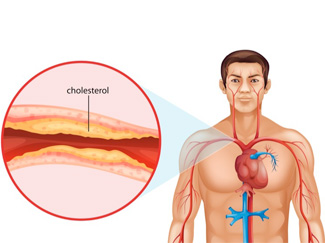Diagnosis of Cardiovascular Disease
Early diagnosis can significantly reduce further health complications

Find out if you are at risk - get tested
| Test Type | Testing Time | Fee |
| 4 to 6 weeks | $195 Click Here to Order Kit |
All orders received before 3pm PST / 6pm EST are shipped out the same business day. All orders received after 3pm PST / 6pm EST or on weekends or holidays are shipped out the following business day. 24/7 online status check and account management available for all tests.
Diagnosis of Elevated Cholesterol Levels
A simple blood test can be taken to check cholesterol levels. This analysis usually gives a measure of the “good” HDL cholesterol, the “bad” LDL cholesterol and triglycerides. The American Heart Association recommends having your cholesterol levels checked every four to six years from the age of 20 years, and more often for those with an increased risk. This increased risk may be due to family history (indicating a genetic component), excess weight or lack of physical activity, smoking status and the presence of other disorders.
Diagnosis of Atherosclerosis
The diagnosis of atherosclerosis is based on a combination of medical history, a physical exam and test results. The physical exam includes listening for abnormal sounds in the arteries and checking the strength of pulses in different parts of the body. A weak pulse in a leg, foot, arm or hand and a ‘whooshing’ sound are indicative of poor blood flow, which may be due to a blocked artery. Diagnostic tests include the simple blood test described above, an electrocardiogram (to check heart beat, strength and rhythm) and stress testing (to identify abnormal changes when the heart is required to work harder). Chest X-rays are useful to identify signs of heart failure or an angiography can be performed, where a dye is injected into the arteries and any narrowing of the arteries is viewable by X-ray. Echocardiography is an important tool to generate a moving picture of the heart using sound waves, allowing the identification of areas of the heart with poor blood flow, decreased muscle contractions and previously damaged heart tissue. Other imaging techniques include computed tomography (CT) scans or magnetic resonance imaging (MRI) scans.
Diagnosis of Hyperlipoproteinemia Type III
The diagnosis of hyperlipoproteinemia Type III is also based on a combination of factors – symptoms, medical history and test results. Blood tests are used to identify elevated triglycerides, VLDL-cholesterol and blood sugar. These abnormal lipoproteins can be analyzed in the blood sample using a technique called electrophoresis, which separates components based on molecular size. Other diagnostic tests can be used to monitor thyroid, liver and spleen function. If a patient has the characteristic symptoms of hyperlipoproteinemia Type III (high triglycerides, high VLDL-cholesterol, and xanthomas), a diagnosis can be confirmed by DNA testing of the APOE gene. Nearly everyone affected by hyperlipoproteinemia Type III has two copies of the APOE e2 allele. However, not everyone with this genotype will suffer from the disorder, as other factors (genetic, environmental and hormonal) are also involved.
DNA Testing of the APOE gene
A DNA test from a simple, non-invasive cheek swab can identify which APOE alleles an individual has. This test can be done at any age, even before any symptoms occur. Our laboratory offers a DNA test which distinguishes between the three most common APOE alleles – e2, e3 and e4. Individuals that have two APOE e2 alleles have an increased risk of hyperlipoproteinemia Type III and identification of this genotype is diagnostic of the disorder, but only if other disease symptoms are also present. Many people who have the e2/e2 genotype do not suffer from hyperlipoproteinemia Type III, as other genetic, environmental and hormonal factors are required. These other factors are not fully understood. Individuals with one or two APOE e4 alleles have an increased risk of elevated LDL-cholesterol, which contributes to atherosclerosis and cardiovascular disease. However, other factors are also required before disease symptoms occur. So although your APOE genotype alone will not determine whether or not you will suffer from blood cholesterol and sugar problems, it is a good indicator of an individual’s risk. A knowledge of this risk may be all that is needed to adopt a healthier lifestyle to minimize the risk of any complications.
Next, Cardiovascular Disease Treatment »
Recommended Links: Mozaffarian D, Benjamin EJ, Go AS, et al. (2015). Heart disease and stroke statistics—2015 update: a report from the American Heart Association. Circulation. 131: e29-322.
What is Cardiovascular Disease? American Heart Association. (Reviewed 12/18/2014).
Heart Disease in Women. National Heart, Lung and Blood Institute (Updated 04/11/2014)
National Organization for Rare Disorders. Hyperlipoproteinemia Type III
